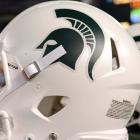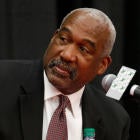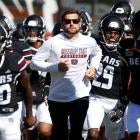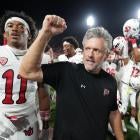After former Michigan State athletic physician Larry Nassar was sentenced to up to 175 years in prison earlier this week for sexual abuse in the USA gymnastics scandal, athletic director Mark Hollis abruptly announced his retirement on Friday morning and the fallout from a growing scandal has moved directly into the Spartans football and basketball programs.
Now we know a little more about what led to Hollis' decision.
According to a report from ESPN's Outside The Lines, a culture of sexual and physical assault existed inside the football and men's basketball program that had not been previously reported. Included in that culture was an effort by the school in court on three separate occasions to withhold names of athletes on public police records within the campus police department, and the redaction of information on public records to a point where the records became useless.
Included in the report are six previously unreported incidents involving the football team. At least 16 Spartan football players have been accused of rape or physical violence since coach Mark Dantonio took over prior to the 2007 season.
In 2010, a woman claimed to campus police that she was raped by two football players in 2009 after a fraternity party. She did not press charges.
In 2013, a student reported an incident with campus judicial services about an incident involving a freshman football player in which she did not consent to sexual intercourse while intoxicated. She did not pursue charges.
In May 2014, the parents of a deceased former student filed a report to campus police detailing a 2007 gang rape involving four football players. Details of the incident were included in the victim's journal, but charges were not brought because the claims could not be verified.
In 2009, a defensive lineman was accused of fighting with his girlfriend. In the report filed with campus police, she claimed the defensive lineman kicked her in the torso, and punched her in the collarbone and under her left eye. She declined to press charges.
Also in 2009, an offensive lineman and his girlfriend got into a dispute in which he admitted to dragging her out of the car and she admitted to vandalizing his property. Both declined to pursue charges.
In 2013, a woman claimed a freshman running back threw her up against a wall after she asked him to say "please" after he requested she take her feet off of a chair in a dorm room. She didn't press charges after receiving an apology in the presence of police.
The report from Outside The Lines quotes former Michigan State sexual assault counselor Lauren Allswede throughout. She alleges that an attorney from the school told her that Dantonio had dealt with a player who had been accused of sexual assault in the past, and "had the player talk to his mother about what he had done."
The complaints against Tom Izzo's basketball program include the coaching staff. Travis Walton, a former player and, at the time, a student-assistant coach for the Spartans, was allowed to stay on staff after being charged in an incident in which he punched a woman at a local bar. The charge was reduced to littering.
Walton would later be named in an allegation of sexual assault of another student. According to the report, that incident was handled by the athletic department internally.
Also included in the report is a more detailed account of an alleged incident involving, at the time, basketball recruits Adreian Payne and Keith Appling. Carolyn Schaner accused them of raping her in a campus dorm after meeting them at orientation. Neither was suspended.
The incidents in the feature from Outside The Lines will bring even more scrutiny to Michigan State, and specifically Dantonio and Izzo.
In virtually every reported accusation -- including the previously unreported incidents -- the campus police allegedly have actively shielded athletes from the public. What's more, there appeared to be a pattern of coaches and administrators within the athletic department having as much, if not more, influence on individual punishment than the university itself and local authorities.






















